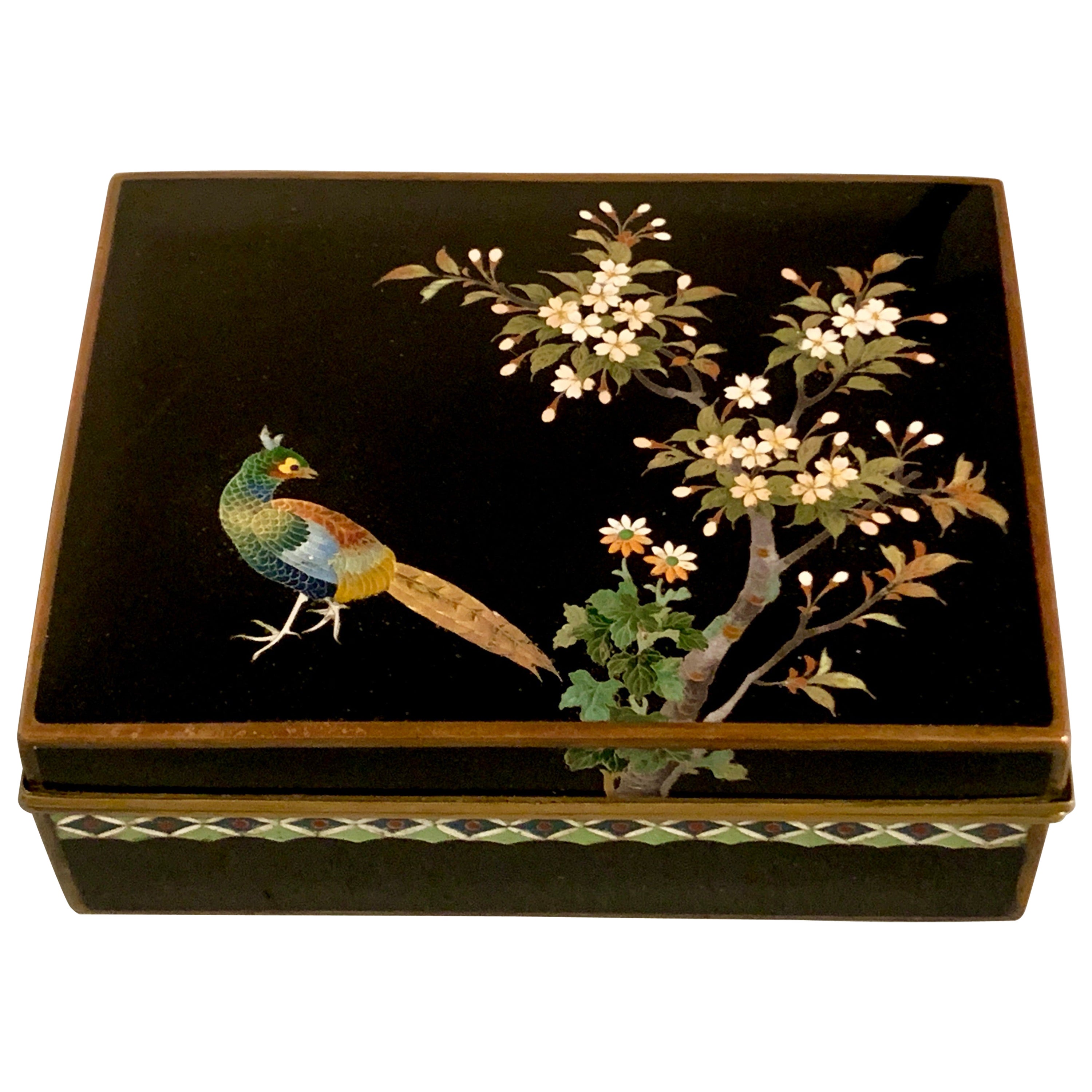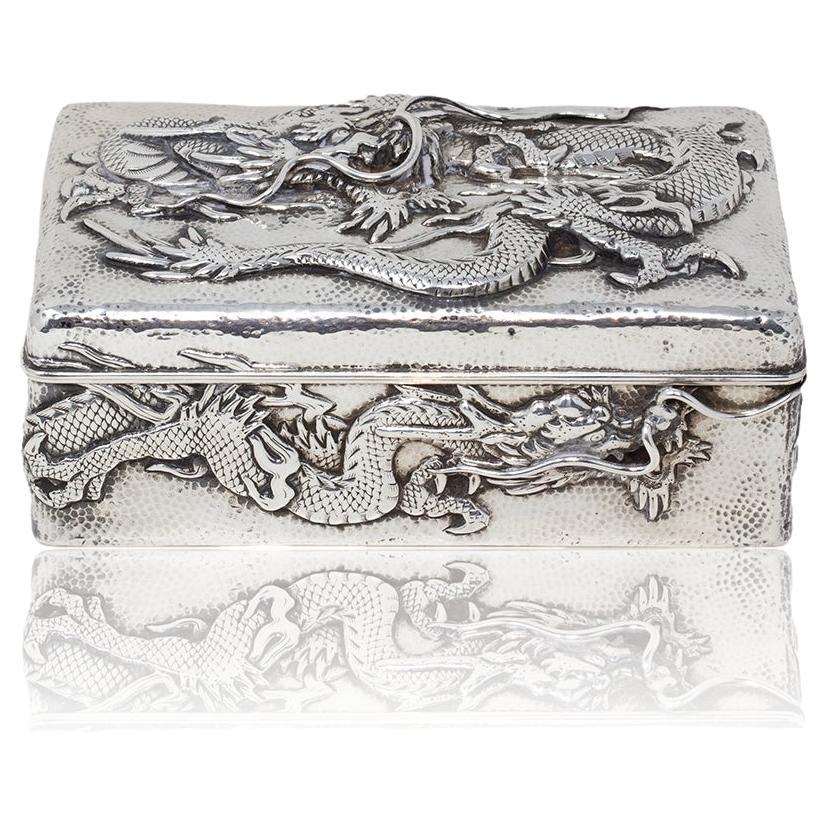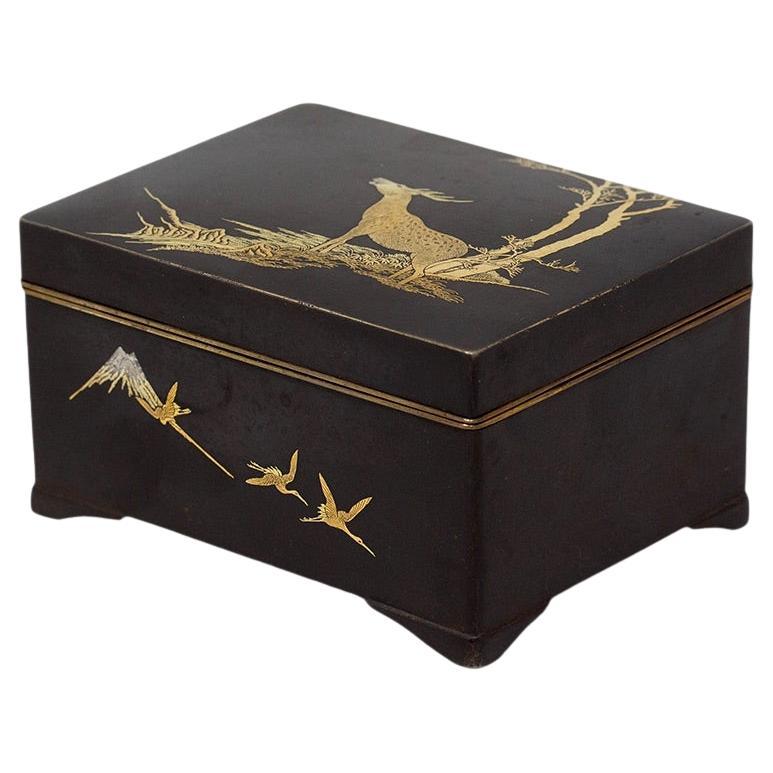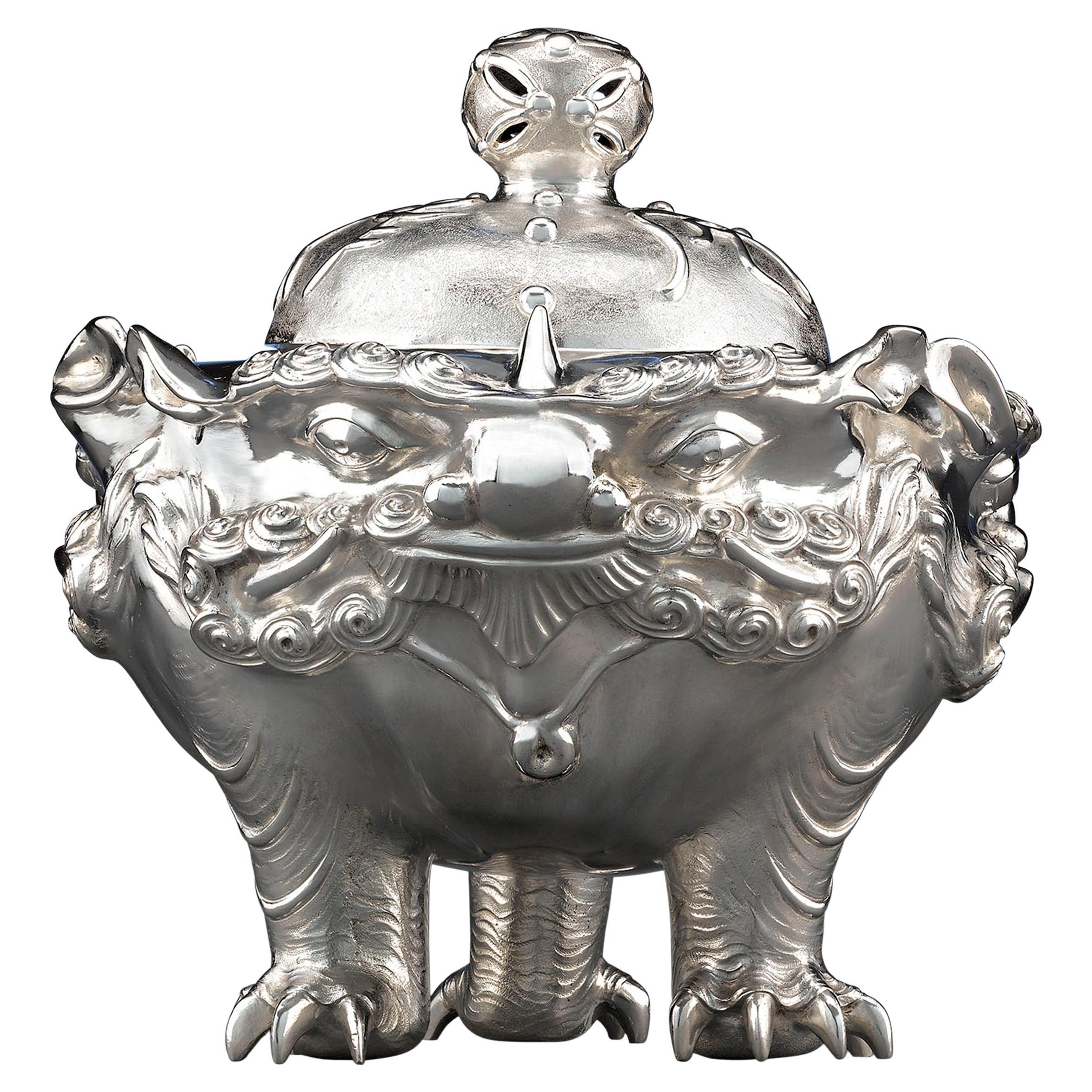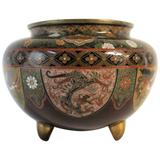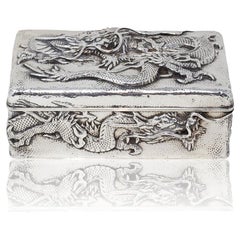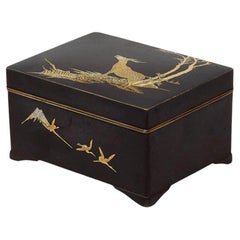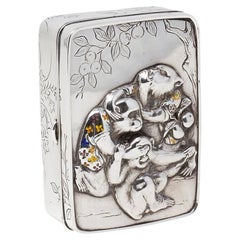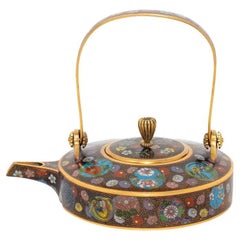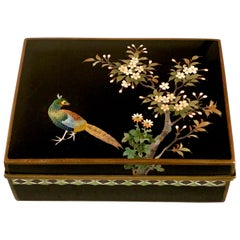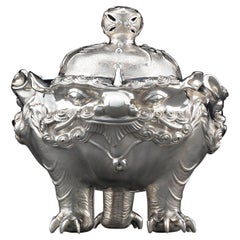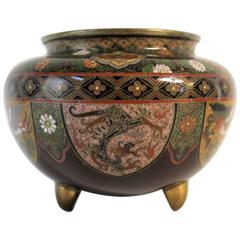Items Similar to Japanese Meiji Period Komai Style Box and Dish Fujii Yoshitoyo
Want more images or videos?
Request additional images or videos from the seller
1 of 20
Japanese Meiji Period Komai Style Box and Dish Fujii Yoshitoyo
About the Item
Original Box and Dish Pair
From our Japanese collection, we are pleased to offer this Japanese Komai Style Box and Dish Fujii Yoshitoyo. The Box of slim rectangular shape seated upon the original matching dish. The Komai Style Box beautifully decorated with an unusual composition of Japanese Tsuba’s with various decoration surrounded by blossoming flowers. Each Tsuba contains its own design including cherry blossom, bamboo and crane birds. The Komai Style Box sits upon the original presentation dish which is decorated with matching design and engraved ‘With The Compliments of J. Konishi’ and is signed to the base with the Yoshitoyo mark (美豊作) above the Fujii mark used by the company. The Komai style box and dish date to the Meiji Period (1868-1912) and the late 19th century circa 1895.
Tsuba is a Japanese term for the area of a sword that is part of a sword mounting and the hand guard. It is mounted between the sword’s blade and grip to protect the user’s hands.
Fujii Yoshitoyo was born in Kyoto, Japan in 1868. Fourth generation metal worker of first rank. He devoted himself to learning about the damascene art and developing the already known techniques used by his family. He left home and moved to Tokyo to develop further and at the age of 35 in 1902 he obtained a patent for his new techniques from the imperial government. In 1909 a second patent was granted to him, he continued to develop his skills and was awarded multiple first class medals throughout his exhibitions and was fortunate enough to sell directly to the imperial household. At its highest point the Fujii factory employer over 200 people mainly exporting sought after objects to Europe and America. During this time he also had his works represented by the Mitsukoshi company. Unlike Komai who use the Zogan (inlay) technique Fujii uses mostly an etching technique on his works.
Meiji Period was an era of Japanese history that spanned from 1868 to 1912. It was the first half of the Empire of Japan, when the Japanese people began to build a paradigm of a modern, industrialised nation state and emergent great power, influenced by Western countries and aesthetics. As a result of radically different ideas, the changes to Japan were profound and it affected the social structure, politics, economy, military, and foreign relations across the board. The period corresponded to the reign of Emperor Meiji and was preceded by the Keio era and was succeeded by the Taisho era.
Cultural Art during the Meiji Period was of particular interest to the government and they overhauled the art export market which in turn promoted Japanese arts via various world’s fairs, beginning in Vienna at the world fair in 1873. The government heavily funded the fairs and took an active role organising how Japan’s culture was presented to the world including creating a semi-public company named Kiritsu Kosho Kaisha (First Industrial Manufacturing Company). The Kiritsu Kosho Kaisha was used to promote and commercialise exports of Japanese art and established the Hakurankai Jimukyoku (Exhibition Bureau) to maintain quality standards. For the 1876 Centennial International Exhibition in Philadelphia, the Japanese government created a Centennial Office and sent a special envoy to secure space for the 30,000 items that would be displayed. The Imperial Household also took an active interest in arts and crafts, commissioning works by select artists to be given as gifts for foreign dignitaries further emphasising the high quality and importance of Japanese art. Just before the end of the 19th century in 1890, the Teishitsu Gigeiin (Artist to the Imperial Household) system was created to recognise distinguished artists. These artists were selected for their exceptionally high quality wares and talent in their own industry. Over a period of 54 years Seventy artists were appointed, amongst these were ceramicist Makuzu Kozan and cloisonné enamel artist Namikawa Yasuyuki.
- Dimensions:Height: 0.4 in (1 cm)Width: 0.4 in (1 cm)Depth: 0.4 in (1 cm)
- Style:Meiji (Of the Period)
- Materials and Techniques:
- Place of Origin:
- Period:
- Date of Manufacture:Circa 1895
- Condition:Wear consistent with age and use.
- Seller Location:Newark, GB
- Reference Number:Seller: JKRDW1stDibs: LU6971239989272
About the Seller
5.0
Gold Seller
Premium sellers maintaining a 4.3+ rating and 24-hour response times
Established in 2019
1stDibs seller since 2022
34 sales on 1stDibs
Typical response time: <1 hour
- ShippingRetrieving quote...Shipping from: Newark, United Kingdom
- Return Policy
Authenticity Guarantee
In the unlikely event there’s an issue with an item’s authenticity, contact us within 1 year for a full refund. DetailsMoney-Back Guarantee
If your item is not as described, is damaged in transit, or does not arrive, contact us within 7 days for a full refund. Details24-Hour Cancellation
You have a 24-hour grace period in which to reconsider your purchase, with no questions asked.Vetted Professional Sellers
Our world-class sellers must adhere to strict standards for service and quality, maintaining the integrity of our listings.Price-Match Guarantee
If you find that a seller listed the same item for a lower price elsewhere, we’ll match it.Trusted Global Delivery
Our best-in-class carrier network provides specialized shipping options worldwide, including custom delivery.More From This Seller
View AllJapanese Meiji Period (1868-1912) Silver Dragon Box
Located in Newark, England
Hammered Silver Decoration Stamped Jungin Pure Silver 純銀
From our Japanese collection, we are pleased to offer a Japanese Meiji Period Silver Dragon Box...
Category
Antique Late 19th Century Japanese Meiji Metalwork
Materials
Silver
Japanese Meiji Period Damascene Box by Ashizuki with Gold and Silver
Located in Newark, England
INLAID WITH A GOLD AND SILVER DEER
From our Japanese collection we are pleased to offer this Japanese Damascene Box by Ashizuki. The Japanese Box of re...
Category
Antique 19th Century Japanese Meiji Metalwork
Materials
Gold, Silver, Brass, Iron
Japanese Meiji Period (1868-1912) Three Wise Monkeys Box Komyo 光明
Located in Newark, England
The Silver box of rectangular form with rounded corners features the Three Wise Monkeys to the front, see no evil, hear no evil and speak no evil. The monkeys cast beautifully with n...
Category
Early 20th Century Japanese Meiji Metalwork
Materials
Silver, Enamel
Japanese Meiji Period Cloisonne Enamel Sake Pot
Located in Newark, England
Fine Japanese Meiji period cloisonne enamel Sake pot. The Sake pot of rounded form with with clean edges profusely decorated with blossoming flowers throughout upon a black ground ba...
Category
Antique Late 19th Century Japanese Meiji Metalwork
Materials
Metal, Enamel
Japanese Meiji Period Cloisonne Enamel Vase by Ando Jubei
By Ando Jubei
Located in Newark, England
Free international shipping
Ando Cloisonne Company Mark
From our Japanese collection, we are delighted to introduce this Japanese Cloisonne Enamel Vase by Ando Jubei. The Cloisonn...
Category
Antique Early 1900s Japanese Meiji Metalwork
Materials
Enamel, Wire
Japanese Meiji Period Cloisonne Enamel Koro signed Tsukamoto Hikokichi
Located in Newark, England
The Koro of exceptional quality shaped in bulbous squat form with three looped handles and removable lid raised on three tapered feet. The Koro with a sky blue ground decorated exten...
Category
Early 20th Century Japanese Meiji Metalwork
Materials
Metal, Enamel, Metallic Thread
You May Also Like
Japanese Cloisonne Box by Inaba, Meiji Period, circa 1900, Japan
By Inaba Cloisonne Co.
Located in Austin, TX
A fine Japanese cloisonne hinged box with pheasant and autumn foliage, by Inaba Nanaho and the Inaba Cloisonne Company, Meiji period, circa 1900, ...
Category
Antique Early 1900s Japanese Meiji Metalwork
Materials
Copper, Enamel, Metal
Japanese Miyao Style Gilt Bronze Samurai Archer, Meiji Period, Japan
By Eisuke Miyao 1
Located in Austin, TX
A spectacular Japanese cast, carved, and parcel gilt bronze sculpture, okimono, of a kneeling samurai archer, signed Kiyotsugu (died 1894), Meiji ...
Category
Antique Late 19th Century Japanese Meiji Sculptures and Carvings
Materials
Bronze
Meiji Period Japanese Silver Censer
Located in New Orleans, LA
This stunning Meiji period silver censer is a work of exquisite detail. Crafted by renowned silversmith Masatoshi of Tokyo, the censer, or incense burner...
Category
20th Century Japanese Meiji Metalwork
Materials
Silver
Japanese Meiji Period Cloisonne Bowl
Located in Hamilton, Ontario
Japanese Meiji period cloisonne bowl.
Category
Antique 19th Century Japanese Meiji Metalwork
Japanese Meiji Period Bronze and Champlevé Enameled Censer
Located in Long Island City, NY
This Japanese censer incense burner, inspired by Chinese pieces, is of spheroidal form, the bronze body with polychrome champlevé enamel work flanked b...
Category
Antique Early 1900s Japanese Meiji Metalwork
Materials
Bronze
A Fine Japanese Cloisonné-enamel kogo box. Meiji period
Located in London, GB
A Fine Japanese Cloisonne Enamel Kogo Box.
Meiji period.
Worked in silver wire and decorated with cranes in flight on a dark blue background.
Interior in black enamel.
In go...
Category
Antique 19th Century Japanese Metalwork
Materials
Enamel
Recently Viewed
View AllMore Ways To Browse
Emperor Japan
Japanese Metal Flower
Etched Metal Art
Military Box
Japanese Sword Furniture
Antique Box Seat
Japanese Meiji Period Box
Sword Box
Japanese Metal Box
Metal Inlay Box
Antique Furniture Tokyo
Centennial 1876
Meiji Cranes
Antique Bamboo Box
Cherry Arts And Craft
Japanese Enamel Box
Antique Japanese Sword
Antique Japanese Swords
